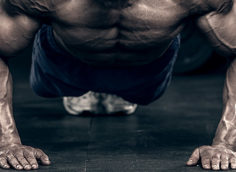Knee pain is typically located right below the kneecap, which is known as patellar tendon pain or tendinopathy. When that pain persists, the pro you seek out will usually prescribe exercises for it – ones in which the lowering (eccentric) phase is emphasized. But these movements are often painful to perform and have even been known to exacerbate the pain. There's a better solution, one that immediately relieves angry knees.
Isometrics (tension without movement) target the muscles and tendons surrounding the area under the patella, where the knee pain occurs. It doesn't just make the area feel better the moment you do it, it allows you to train or compete pain-free.
If you can take the time to rehab, then the eccentric knee exercises your doc prescribes should be your first choice. If not, give this a shot.
- Get a box. You'll need one high enough to let your feet rest on the floor. Make sure that it'll allow you to find the 60 degree knee angle as shown here. Use this picture to get an idea of (about) how bent your knee should be.
- Position yourself close to a solid beam to push against, something like a squat rack or dumbbell rack.
- Use a foam pad between you and the beam to provide padding for your shin and foot.
- Extend your leg against the beam for 45 seconds at around 70% of your full effort.
- Rest two minutes and repeat for a total of 5 sets or until you feel the pain is gone from movements that cause discomfort.
- You may find you need more or less than this. Play around with it, but always err on the side of caution and start conservatively.



Researchers actually investigated the two different methods that might immediately reduce patellar tendon pain: isometric and isotonic exercises. Remember, isometric exercise is where force is applied with no change in muscle length (e.g. trying to push the wall of your house). Isotonic exercise is characterized by having a concentric and eccentric phase (upwards and downwards, like a squat).
The subjects were six male volleyball athletes diagnosed with patellar tendinopathy. They had pain just below the kneecap while jumping, landing, and even doing the activities prescribed to relieve the knee pain.
What did the study find? Isometric exercise significantly reduced pain and pain alleviation was sustained for 45 minutes post isometric exercise. Isotonic exercise resulted in pain relief too, but it wasn't sustained as long.
- Rio E et al. Isometric exercise induces analgesia and reduces inhibition in patellar tendinopathy. Br J Sports Med. 2015 Oct;49(19):1277-83. PubMed.





